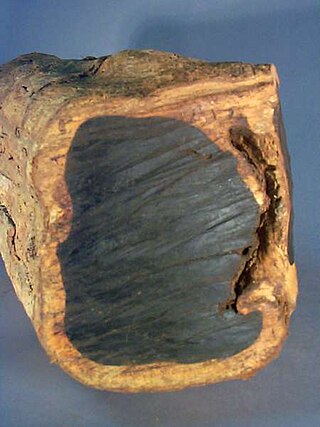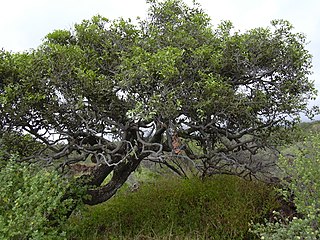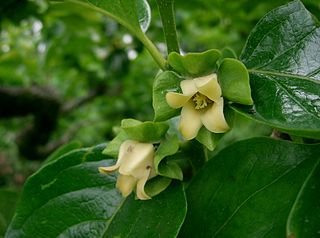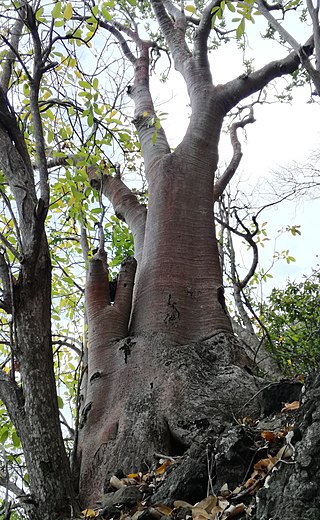
The persimmon is the edible fruit of a number of species of trees in the genus Diospyros. The most widely cultivated of these is the kaki persimmon, Diospyros kaki – Diospyros is in the family Ebenaceae, and a number of non-persimmon species of the genus are grown for ebony timber. In 2019, China produced 75% of the world total of persimmons.

Ebony is a dense black/brown hardwood, coming from several species in the genus Diospyros, which also includes the persimmon tree. A few Diospyros species, such as macassar and mun ebony, are dense enough to sink in water. Ebony is finely textured and has a mirror finish when polished, making it valuable as an ornamental wood. It is often cited as one of the most expensive woods in the world.

The Ebenaceae are a family of flowering plants belonging to order Ericales. The family includes ebony and persimmon among about 768 species of trees and shrubs. It is distributed across the tropical and warmer temperate regions of the world. It is most diverse in the rainforests of Malesia, India, tropical Africa and tropical America.

Diospyros is a genus of over 700 species of deciduous and evergreen trees and shrubs. The majority are native to the tropics, with only a few species extending into temperate regions. Individual species valued for their hard, heavy, dark timber, are commonly known as ebony trees, while others are valued for their fruit and known as persimmon trees. Some are useful as ornamentals and many are of local ecological importance. Species of this genus are generally dioecious, with separate male and female plants.

Diospyros virginiana is a persimmon species commonly called the American persimmon, common persimmon, eastern persimmon, simmon, possumwood, possum apples, or sugar plum. It ranges from southern Connecticut to Florida, and west to Texas, Louisiana, Oklahoma, Kansas, and Iowa. The tree grows wild but has been cultivated for its fruit and wood since prehistoric times by Native Americans.

Diospyros melanoxylon, the Coromandel ebony or East Indian ebony, is a species of flowering tree in the family Ebenaceae native to India and Sri Lanka; it has a hard, dry bark. Its common name derives from Coromandel, the coast of southeastern India. Locally it is known as temburini or by its Hindi name tendu. In Odisha, Jharkhand, and Assam, it is known as kendu. In Andhra Pradesh, and Telangana it is known as tuniki. The leaves can be wrapped around tobacco to create the Indian beedi, which has outsold conventional cigarettes in India. The olive-green fruit of the tree is edible.

Diospyros mespiliformis, the jackalberry, is a large dioecious evergreen tree found mostly in the savannas of Africa. Jackals are fond of the fruit, hence the common names. It is a member of the family Ebenaceae, and is related to the true ebony and edible persimmon.
The wildlife of Mauritius consists of its flora and fauna. Mauritius is located in the Indian Ocean to the east of Madagascar. Due to its isolation, it has a relatively low diversity of wildlife; however, a high proportion of these are endemic species occurring nowhere else in the world. Many of these are now threatened with extinction because of human activities including habitat destruction and the introduction of non-native species. Some have already become extinct, most famously the dodo which disappeared in the 17th century.

Polyscias rodriguesiana is a rare species of plant in the family Araliaceae.

Diospyros texana is a species of persimmon that is native to central, south and west Texas and southwest Oklahoma in the United States, and eastern Chihuahua, Coahuila, Nuevo León, and Tamaulipas in northeastern Mexico. Common names include Texas persimmon, Mexican persimmon and the more ambiguous "black persimmon". It is known in Spanish as chapote, chapote manzano, or chapote prieto, all of which are derived from the Nahuatl word tzapotl. That word also refers to several other fruit-bearing trees.

Diospyros mabacea, the red-fruited ebony is a rare rainforest tree in the ebony or persimmon family growing in north eastern New South Wales. Listed as endangered by extinction.

Diospyros dichrophylla (Gand.) De Winter is a Southern African tree belonging to the ebony family of Ebenaceae and closely related to the Persimmon.

Bras d'Eau National Park is one of only three national parks in Mauritius. It is located in the north-east of the island.

Cyphostemma mappia is a species of caudiciform succulent plant endemic to Mauritius. It is sometimes known as the "Mauritian baobab", though it is member of the grape family (Vitaceae) and unrelated to the true Baobabs of Africa.

Diospyros tessellaria is a species of tree in the family Ebenaceae.

Diospyros revaughanii is a rare species of tree in the family Ebenaceae (ebony).

Ile aux Aigrettes is an islet off the south-east coast of Mauritius. It functions as a nature reserve and a scientific research station. It is also a popular visitors attraction — both for tourists and for Mauritians.

Diospyros egrettarum is a species of tree endemic to Mauritius and was once a dominant species throughout dry and coastal forests. Due to harvests for timber and firewood in the past the species was reduced to fewer than 10 individuals on the main land. The only viable population remained on Île aux Aigrettes, a coral island off the east coast, where it was able to survive thanks to protective measures, such as the eradication of exotic plants and rats. The tree is named after this Island.

Pandanus eydouxia is a species of plant in the family Pandanaceae, endemic to Mauritius.

Diospyros paniculata, or the panicle-flowered ebony, is a species of tree in the ebony family. Endemic to the Western Ghats area of India and parts of Bangladesh, the species is currently listed as Vulnerable in the IUCN Red List.



















